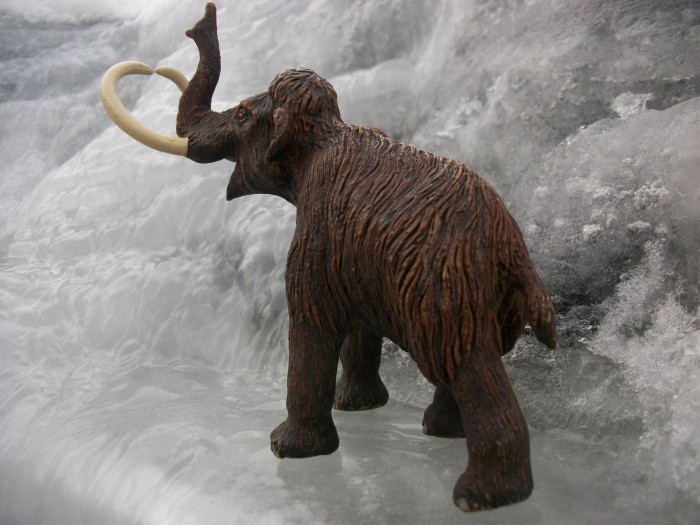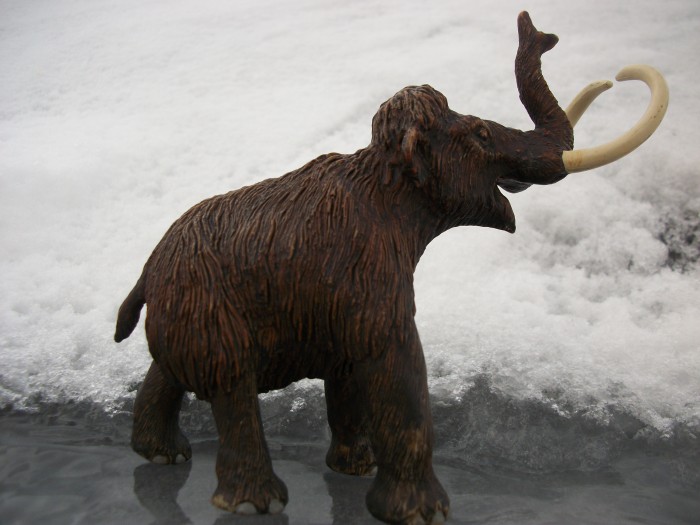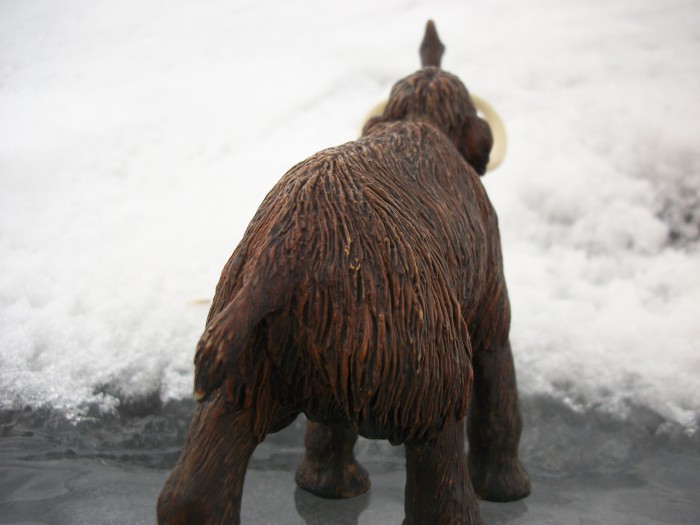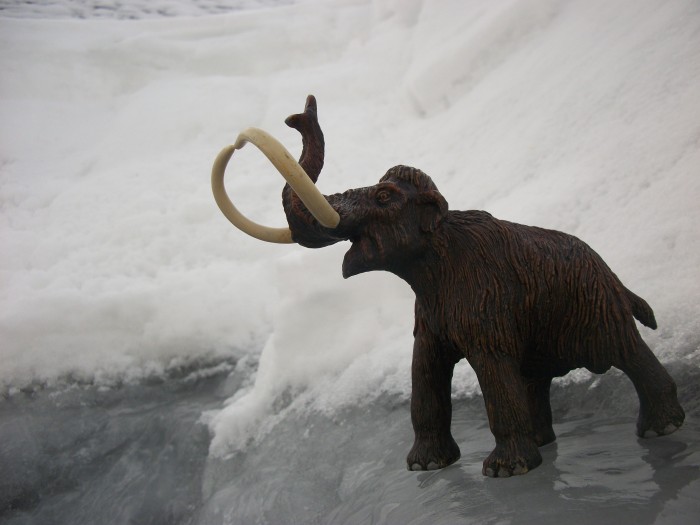Many years ago when I was a small child, I thought all of the ancient mammoths where the Woolly Mammoth. I later learned that it was a diverse branch with many different members. The first mammoth bones I had ever seen in person were at the Mammoth Site in South Dakota, where a majority of the mammoth remains are of the Columbian variety, but there are also a few remains of the Woolly Mammoth as well. It was an amazing sight to see. Ancient Mammoths still seem to capture our imagination; you almost feel a kinship with them, like a long lost family member.
The Woolly Mammoths (Mammuthus primigenius ) are the quintessential image of the Ice Age, a poster child of the Steppe, and a staple of almost every company’s toy line of Dinosaurs – prehistoric animals. The Wild Safari version of the Wooly Mammoth, which was part of the Prehistoric life collection, is not as grand, or spectacular as their Carnegie version, but don’t count this figure out just yet.
The Woolly Mammoth was about the size of today’s African Elephants, which is large, but by no means the biggest in the family. The toy is moderately sized about 11-12 cm high and 16cm long. On this model the head and short trunk are raised with its mouth agape. There is a hairy dome present on its head, then above the shoulders there is a very small hump, and then the back slopes downward from the hump to the rump. These features are characteristic of the species, and it was depicted that way in cave paintings by early humans. Also on the head are prominent brow ridges and very small ears the stick out on either side. Adult Woolly Mammoths could effectively defend themselves from predators with their tusks or use them for everyday tasks. The two tusks on this model jut out from sides in a manner that would be typical for the species.
On the trunk, an interesting feature is the Upper finger at the tip of the trunk. On the Woolly Mammoth, as it is on this model, the upper finger was a long and pointed lobe, while the lower was broader. The length of an adult Mammoth was around 2 meters long (over 6 ft long); on this model it looks a little short.
As you would expect, if an animal is called Woolly, the expectation would be a lot of hair. The figure does not disappoint. The coat of Woolly Mammoths had an outer layer of guard hairs on the upper body, flanks, and on the underside. This is all present on this model. The texture clearly shows long lines of hair covering the body, even underneath where all the long hair meets and forms a ridge. On the legs you can see were the shaggy upper coat ends and the long leg hair begins. The head is covered in hair, in reality it should be shorter than what is depicted. The short tail also has course hair that ends in a tuft.
The color is two toned with different shades of brown, which looks good and is accurate. There is a dark brown undercoat, were the guard coat of fur is a little more light brown. The toes are painted in grey. Curiously the eyes are completely brown with black pupils. Inside the mouth is a small splash of pink for the tongue and sides. The tusks are an off white; I guess it could be ivory.
It is a toy that will please most kids as it is perfectly suited to be played with. The pose is interesting and useful for playing with, so most kids will probably like this toy. The paint does wear with time, but is hardly noticeable. It can hold up to rough style of play from kids who like to smash their way through wooden blocks. The tusks are not sharp so there is no worry there.
Overall this figure comes through with an exciting pose and texture that would please most people who like Mega Fauna. One of the things I like most about this figure compared to its Carnegie brethren, is the two tone color of it hair. It really stands out, were the Carnegie single color makes it a little boring and less lifelike. It is a smaller figure and is easily dwarfed by the Carnegie version. There are some inaccuracies with it but they are hardly noticeable. It is a solid figure that is currently easy to find and affordable.
Available many places including Amazon.com here.
Disclaimer: links to Ebay and Amazon on the DinoToyBlog are affiliate links, so we make a small commission if you use them. Thanks for supporting us!









[…] the biggest prehistoric mammal in the Wild Safari line to date, easily humbling the Amebelodon and woolly mammoth! Based on the abundant fossil remains, the average mastodon grew to the same weight as a modern […]
[…] the Chicago Field Museum store carried it for a number of years. It is very similar in shape to the Safari Ltd woolly mammoth figure if you compare the two, despite the obvious difference of one being plastic and the other being a […]
[…] tall, putting these figures at around 1/24 scale. They aren’t exactly to scale with the Safari woolly mammoth, but there’s enough size difference between them that it doesn’t look […]
Another interesting fact: its pose is almost identical to one of the lifesize mammoth sculptures outside the Canadian Museum of Nature in Ottawa. This is no coincidence — Doug Watson sculpted them both!
Thanks for sharing that information, I did not know that. Very cool!!! 🙂
[…] completing the 2004 Wild Safari Prehistoric Life Woolly Mammoth review, it was brought to my attention that I should take a look at the retired WS Baby. With this […]
Nice review Laticauda. Worth mentioning that there is also a well sculpted calf that goes with this. My youngest daughter really enjoyed playing with them, with the mummy mammoth well poised to protect its baby!
Actually, this is my kids mammoth. I do not have the calf, but now that you mention it, it might be worth looking for. Good idea!
The pictures of the mammoth in the snow are awesome! Thanks Laticauda, very cool!
Also, for those who care about such things, while the Carnegie mammoth is 1:30 scale, the Safari mammoth is closer to 1:40.